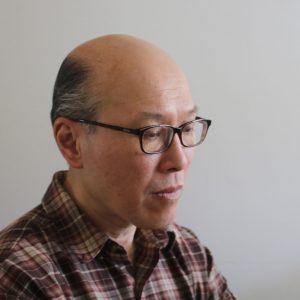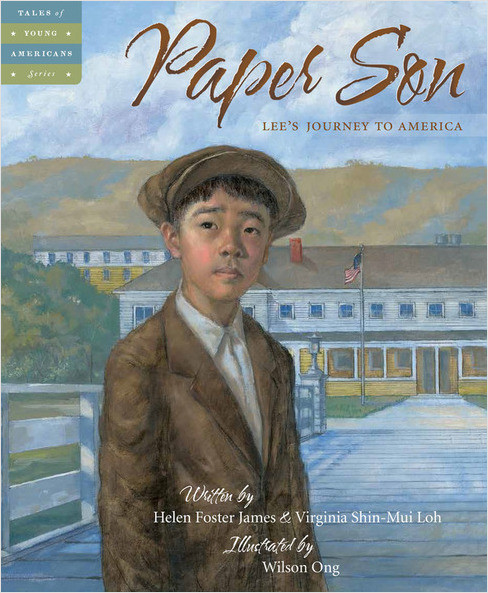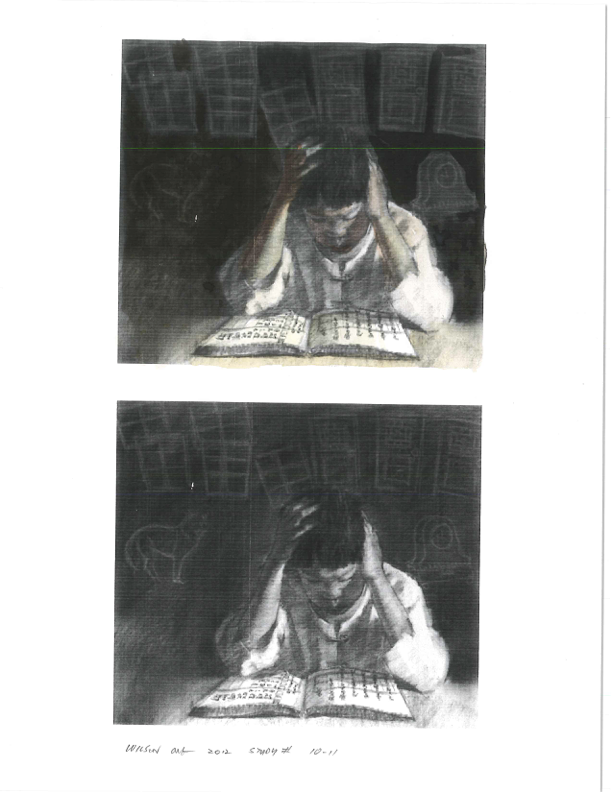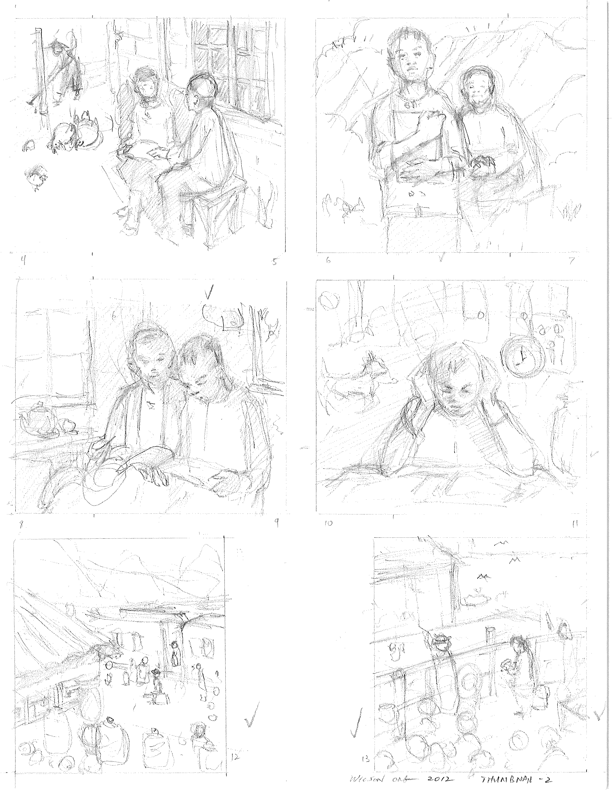By Kathy G. Short, University of Arizona, Tucson, AZ
 Mary J. Wong recently donated the entire set of original oil illustrations for Paper Son: Lee’s Journey to America by Wilson Ong to the Worlds of Words Center along with his thumbnail sketches and color studies. In working on the exhibition, we wanted to include Wilson’s perspective and process in creating the illustrations and so interviewed him, gaining many useful insights into his process and the connection of the book to his family story.
Mary J. Wong recently donated the entire set of original oil illustrations for Paper Son: Lee’s Journey to America by Wilson Ong to the Worlds of Words Center along with his thumbnail sketches and color studies. In working on the exhibition, we wanted to include Wilson’s perspective and process in creating the illustrations and so interviewed him, gaining many useful insights into his process and the connection of the book to his family story.
Wilson Ong is a fine art painter who works in oils. His expertise is portraiture, but he also paints landscapes and occasionally illustrates children’s picturebooks. He has a degree in painting and drawing from Brigham Young University and furthered his studies at the Art Students’ Leage in New York City, studying with figurative artists Ted Seth Jacobs and Harvey Dinnerstein, an opportunity he considers transformative. Wilson lived in Corning, New York for many years but now resides in Idaho where he paints portraits and landscapes and teaches workshops on painting.
 Paper Son, written by Helen Foster James and Virginia Shin-Mui Loh (2013), is set in 1926 and tells the story of a 12-year-old boy from a small village in rural China who lives with his grandparents. Because of their poverty, his loving grandparents want to provide him with more opportunities and so purchase a “paper son slot.” Being a paper son means pretending to be the son of a Chinese family already in the U.S. and passing a rigorous test at the Angel Island Immigration Station in San Francisco. He must diligently study his coaching book to memorize every detail about his paper family because if he makes any mistakes, he will be sent back to China, wasting his grandparents’ money. The Chinese Exclusion Act, 1882-1943, banned Chinese immigrants from entering the U.S., with only a few exceptions, resulting in practices such as paper sons and paper daughters.
Paper Son, written by Helen Foster James and Virginia Shin-Mui Loh (2013), is set in 1926 and tells the story of a 12-year-old boy from a small village in rural China who lives with his grandparents. Because of their poverty, his loving grandparents want to provide him with more opportunities and so purchase a “paper son slot.” Being a paper son means pretending to be the son of a Chinese family already in the U.S. and passing a rigorous test at the Angel Island Immigration Station in San Francisco. He must diligently study his coaching book to memorize every detail about his paper family because if he makes any mistakes, he will be sent back to China, wasting his grandparents’ money. The Chinese Exclusion Act, 1882-1943, banned Chinese immigrants from entering the U.S., with only a few exceptions, resulting in practices such as paper sons and paper daughters.
Wilson was offered the opportunity to illustrate this picturebook because of the connections to his own family story and his illustration work with the publishing company (Sleeping Bear Press) on a previous book, T Is for Tutu (Rodriquez & Browning, 2011). While Wilson’s father was reluctant to talk about his own journey to the U.S., he came as a paper son when he was 12 but was sent back to China and tried again to enter the U.S. at age 18 in 1947. Wilson is named after the steamship that brought his father to the U.S., the Woodrow Wilson. The family’s paper son name was Wong. The family used that name until Wilson was in fourth grade, and his father revealed that their family name was actually Ong and changed their name. An immigrant forgiveness law made it possible for his father to reclaim his actual family name. Wilson said, however, that his father did not talk about his own journey or process of becoming a paper son, noting this was true for many Chinese immigrants from that time who feared deportation and worried that a new law would change their status. They did not want to put their families at risk.
In researching for the illustrations, Wilson noted the drab colors of villages in China, feeling that the high humidity often seemed to mute and wash out the greens in the photographs he took from earlier visits to the region where his father grew up. He spent a great deal of time accessing photo archives and books about Angel Island and visited a museum with clothing from that time period.

Wilson was provided a script for the book where the designer had already taken the written manuscript and divided the text into pages, so his first step was to make thumbnails and a story board of possible illustrations and send them to the editors. Upon approval, he then moved to the actual drawings, arranging for models to be photographed and using the sketches as a guide. He asked his wife and two brothers that he had met during one of his daughter’s piano lessons to pose as models to photograph for particular scenes and used old photographs of his grandmother. Using these resource materials, he drew each illustration on canvas in charcoal and submitted the images to the editor. After approval was granted, he photographed and printed out the charcoal drawings and used the copies for color studies to create a flow of colors from page to page. At this point he was ready to complete the illustrations by painting over the charcoal drawings in oils. He created a thin layer of oil paint over the charcoal drawings on the canvas so that the paints would dry quickly because he had so many illustrations.

If viewers look carefully at the illustrations in the book, the charcoal lines are visible in some of the images. The lines can be seen due to the thin layer of oil paints used by Wilson but also because of the photography process used for printing purposes. Wilson noted that oil paints do not photograph as well as watercolors due to their reflective and varied surface qualities and that often the colors of original oil illustrations have subtleties that are not evident in the illustrations in the published book. In his case, the published illustrations show more of the charcoal lines than the original illustrations because the camera saw through the thin oils to catch the opaque charcoal lines.
In his portraiture, Wilson uses a more involved process of painting many layers of oils over a long period of time, gradually laying on layer after layer of color. On a section of his website, he shows this process of layering paints over time for two different portraits. In a single painting, he has time to build up layers of paint, but that process would greatly extend the amount of time needed to paint the number of illustrations needed for a picturebook.
Wilson began drawing seriously in first grade, labeling his drawing as serious because drawing became part of his identity, and he began comparing himself to his peers. He started winning contests and sought ways to get better as an artist. He remembers drawing a figure in the fourth grade, frustrated with not getting the ears right, critiquing himself as an artist. He had an inner drive to better himself.
Wilson grew up working in his family’s Chinese restaurant and often drew on the backs of advertisements for the restaurant. His parents did not encourage him as an artist but did not discourage him either. His teachers in grade school and high school noted his ability and provided him with encouragement but little significant critique or direct instruction. His instruction in college was similar mainly because he was shy and rarely asked questions, and so was easily overlooked. Instead, he learned to practice and observe as a means of teaching himself. It was not until he went to NYC at the Art Students’ League that he was able study under artist instructors who opened his understandings of drawing and painting. He also taught art to students grades 4-12 at a private school early in his career and more recently for a year in high school. He found that explaining to children and teens allowed him more conscious awareness and manipulation of the principles of art in his own work.
Wilson has had many exhibits and pieces of art shown at various galleries and juried exhibitions. His most recent show is rural landscapes featuring water, which has been a focus for him recently due to their peaceful nature. His website includes a section showing some of his landscape pieces.
Oil is the medium that Wilson has worked in consistently throughout his career. Initially, he chose oil because oil represented being a serious artist to him as a source of artistic respect. Now, it’s the medium in which he is most comfortable. On his website, he says that oil painting is his primary medium because he finds it so versatile. “This medium allows me to be spontaneous and calculated depending on the value of what I am painting.” Wilson states that he sees painting as a privilege, a statement that is reflected in the respect evident in his illustrations for Paper Son and in his portraits.
An exhibition of Paper Son is in the Worlds of Words studio from August 22 to December 16, 2022 that includes the original paintings for the book as well as the thumbnails and some of the color studies. In addition, a copy of a study book from Mary Wong’s family is on display. Original study books are extremely rare because they were thrown overboard as ships entered the San Francisco harbor out of fear that they would be found by immigration officers. Because this set of paintings are part of the permanent collection of art at Worlds of Words, they can be accessed at Worlds of Words after the exhibition through special request.
Authors’ Corner is a periodic profile featured on our blog where authors discuss their writing process and the importance of school visits. Worlds of Words frequently hosts these authors for events in the collection. To find out when we are hosting an author, check out our events page. Journey through Worlds of Words during our open reading hours: Monday-Friday, 9 a.m. to 5 p.m. and Saturday, 9 a.m. to 1 p.m.
- Themes: Kathy Short, Paper Son, Wilson Ong
- Descriptors: Authors' Corner
